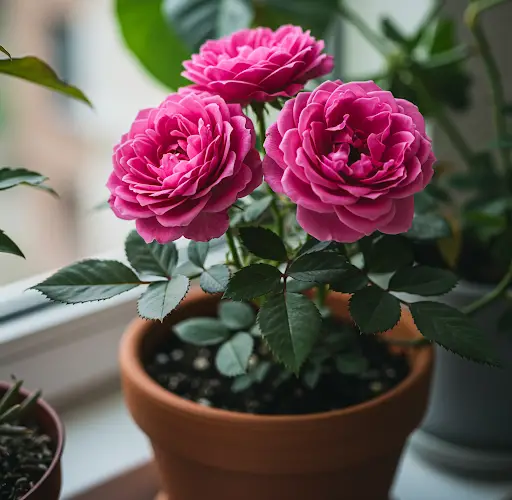Effective Care and Disease Prevention for Lush, Healthy Roses
Roses are among the most beautiful and beloved flowers in any garden, but they require diligent care to ensure they bloom luxuriantly. Proper pruning, loosening the soil, abundant watering, and overall health maintenance are key factors in achieving vibrant and resilient rose bushes. However, one of the biggest challenges in growing roses is their susceptibility to a variety of diseases. To protect them from common ailments such as powdery mildew, black spot, gray mold, rust, and others, it is essential to implement a strong preventive care routine.
Many plant diseases are difficult to detect in their early stages. A rose bush may appear healthy, but under unfavorable conditions, it can quickly develop infections that weaken and eventually kill the plant. Regular preventive treatments are essential for strengthening the plant’s immunity and ensuring resilience against stressors such as cold weather, water stagnation, drought, and pathogens. By reinforcing their natural defenses, roses can not only survive but thrive, displaying lush foliage and abundant blooms.
A Powerful Homemade Remedy for Disease Prevention
One of the most effective ways to enhance the immunity of roses and other flowering plants is through a simple yet powerful treatment made from common pharmaceutical ingredients. This remedy not only helps prevent diseases but also promotes healthy growth and lush flowering. The solution is easy to prepare and can be applied regularly to maintain the overall well-being of the plants.
Ingredients Needed:
- 1 liter of warm water
- 40 milliliters of a 2% alcohol solution of salicylic acid
- 1 tablespoon of 10% ammonia solution
- 5 liters of additional water for dilution
Preparation and Application
- Mix the Ingredients: Start by taking one liter of warm water and dissolving 40 milliliters of a 2% alcohol solution of salicylic acid in it.
- Add Ammonia: Next, add one tablespoon of a 10% ammonia solution to the mixture.
- Dilute the Solution: Stir the mixture well and then dilute it further by adding five liters of water. Mix thoroughly to ensure the solution is well-blended.
- Application Method: The prepared solution should be sprayed onto the leaves of roses, as well as other garden flowers and houseplants.
- Best Time for Application: Apply this treatment either in the evening or early morning to avoid rapid evaporation and ensure maximum absorption by the plants.
Benefits of This Top Dressing
This homemade treatment offers several advantages for plant health and growth:
- Enhances Immunity: The combination of salicylic acid and ammonia works to strengthen the natural defenses of the plants, making them more resistant to various diseases.
- Promotes Growth: The presence of ammonia provides a mild nitrogen boost, which contributes to the development of lush green foliage and strong stems.
- Increases Disease Resistance: Regular use of this solution protects roses from fungal and bacterial infections, ensuring their long-term vitality.
- Prepares Plants for Stress Conditions: Whether facing cold temperatures, excessive moisture, or drought, plants treated with this solution become more resilient to environmental stress.
- Encourages Luxurious Blooming: By improving overall plant health and providing essential nutrients, this treatment leads to more abundant and vibrant blossoms.
Frequency of Use
For optimal results, this treatment should be applied every two to three weeks. Regular application ensures continued protection against diseases and supports steady growth throughout the season.
Additional Tips for Healthy Roses
In addition to this preventive treatment, there are several other practices that contribute to the health and beauty of rose plants:
- Pruning and Deadheading: Regularly trimming dead or weak branches helps maintain the shape of the plant and encourages new growth. Removing spent flowers (deadheading) also stimulates further blooming.
- Proper Watering: Roses need deep, consistent watering, especially during dry periods. It is best to water them at the base rather than on the leaves to prevent fungal infections.
- Good Air Circulation: Ensuring proper spacing between rose bushes allows for good air movement, reducing humidity and the risk of fungal diseases.
- Mulching: Applying a layer of mulch around the base of the plants helps retain moisture, suppress weeds, and protect the roots from temperature fluctuations.
- Balanced Fertilization: Roses benefit from a balanced feeding regimen that includes nitrogen, phosphorus, and potassium. Organic fertilizers, such as compost and well-rotted manure, also contribute to soil health.
- Monitoring for Pests: Common rose pests include aphids, spider mites, and thrips. Regularly inspecting plants and using natural remedies, such as neem oil or insecticidal soap, can help keep infestations under control.
Conclusion
Roses, with their enchanting beauty and captivating fragrance, are a rewarding addition to any garden. However, to achieve their full potential, they require diligent care and preventive treatments. The homemade solution using salicylic acid and ammonia provides an excellent method for boosting plant immunity and preventing common diseases. Combined with proper pruning, watering, and fertilization, this approach ensures that roses remain healthy, vibrant, and full of life throughout the growing season. By implementing these simple yet effective strategies, gardeners can enjoy a stunning display of flourishing roses year after year.



